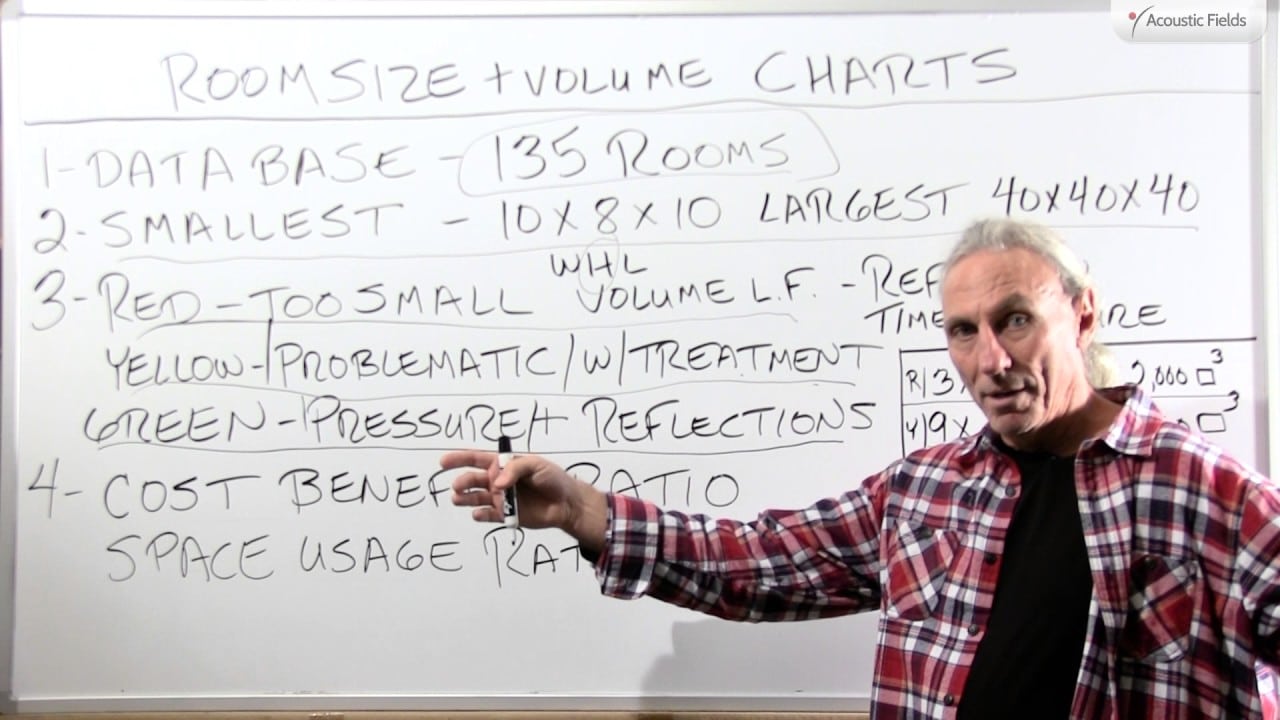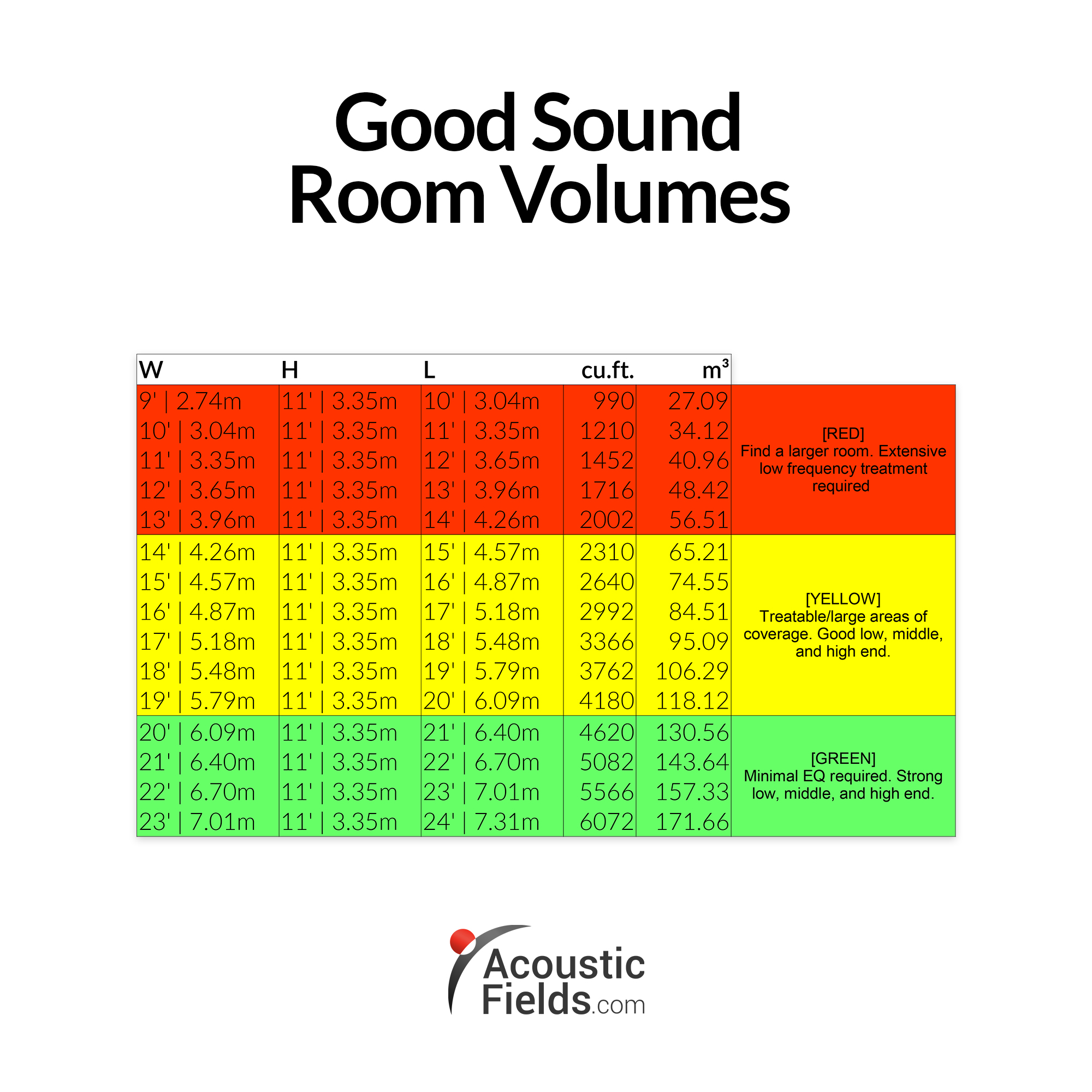We have a room size and volume chart that most of you have seen if you’ve sent in the room form where you’ve listed your dimensions and usage and equipment that you’re going to have in the room. We send you back one of our room forms or one of our room charts so you could compare your room size and volume with our database.
Now we have a database of a hundred and thirty-five rooms that we built measured so in that database I started to study it and I started to try to get a balance for customers on treatment versus expense, versus size and volume to try to give you a feel for where your room fits in, to what the problems are and what you have to do to manage those problems so we have a database that has a room that’s the smallest in a ten by eight by ten and we always express our dimensions in the acronym WHL which stands for Women Have Legs, probably a little sexist but nonetheless that’s what they’ve been using in the carpentry world for years. so whenever you express dimensions it’s always with height and length, the height, just remembered is in the middle, that’s how I remember it so. Then our largest room is 40 by 40 by 40 so we have a whole 133 rooms somewhere between these two dimensions and I guarantee you your room is in our database.
So I went through our database and I started breaking it up into categories because I wanted to come up with a way to say your room is just so small it doesn’t work on any of the parameters that we need no matter how much money you would pour into it you’d be better to go and seek a larger room and secondly the amount of treatment you’d have to put in the room probably wouldn’t leave you a place to sit, I mean your room is that small. In physics in order to improve upon a room we have to make it smaller because most of the time we can’t make it larger. If it’s got too much low-frequency pressure in it because it’s too small we have to put a lot of sponges so to speak in it. We think of our room as a glass of water and the low frequency energy is the , the water is overflowing the glass so we can get a bigger glass or we can put less water in it or we can drop sponges in the glass and lower the existing water level.
So there’s all kinds of ways to do this and with our room size and volume charts I try to give you some break points to work with so in our red area it’s just simply too small, you really need to find another room and a breakpoint on the red area would be 13 wide ,11, 12, 14 long, less than 2000 cubic feet… that’s our red breakpoint and now anything smaller than that obviously is still too small but the reason it’s too small is because like I said the amount of treatments that you have. You can get good sound out of it, I’m not saying you can’t but what I’m saying is it’s too small in terms of cost and benefit. You have to put so much money in treatment that if you’ve got a room that was maybe another foot or two in either direction you might be able to save 50% in treatment costs. So I try to give you these break points based on our experience in our database of what will work, what won’t work, what will cost you a lot, what won’t cost you so much and give you some ideas of size. So it’s not absolute, it’s based on 135 rooms which is a pretty viable statistically significant sample if you think about it.
So the yellow area in our chart is 19, 11 and 20 wide following our acronym, 11 high and 20 long okay so that’s less than 4100 cubic feet so we have some volume here so the yellow is problematic with low frequency but it is treatable and you will have some room to move around in so that’s the contrast with the red and the yellow and obviously the green is a nice balance between pressure and reflections because you have volume. Now you have to realize in room we have two issues, we have pressure and reflections; we have to treat the pressure and the low-frequency issues first then we have to manage the reflections. So we have these two variables that we have to constantly juggle and reflections are a lot easier with absorption and diffusion to deal with but they do take a lot of surface areas and they can make the room smaller but the pressure, the low-frequency issues that can really make the room smaller. Our low frequency carbon technology inside of a room takes 16 inches if you build it from the ground up in every wall surface, for ceilings and side walls so you’re going to give up 3 feet in the width so we have to program that into the design when we’re building something new but much more cost-effective to build it into the walls than having a bunch of freestanding units by about 50%.
So you always have to look at all of these issues, what is the size of my room, what are my problems, how much treatment do I have to put in to solve it and more importantly, is that going to work for my usage. Most of you out there that have called me or dealt with me through email, we always know the first thing I ask you is are you making your living in this room because if you are then we have a tighter criteria, we have a tighter quality level that we have to achieve than if you’re just a hobbyist and if you’re in the red zone you’re going to have to find a bigger room if you’re going to make a living in it, that is an absolute because we just simply can’t get you a response curve that will translate in your mixes and I have the most powerful low-frequency technology ever created by mankind so if I can’t help you two things will happen, you won’t be able to do it and I’ll tell you, you won’t. I won’t lie to you ok. So lots of variables to be concerned about and I hope our room size and volume charts will give you some guidelines to go by. So if your room is right on the breakpoint between a red zone and a yellow zone then maybe we can stretch a little bit, find a little bit bigger room and avoid a lot of cost in treatment of the problems of the smaller one.
—
This is an unedited transcript from our video series from Acoustic Fields. There will be some errors in grammar and sentence structure that occur during this translation process.
For complete understanding and comprehension, please view the video which is included in this text. For any additional information regarding this topic or others relating to room acoustics, please contact us directly at:
P: 520 – 392 – 9486









I am building a new room, want to know that whether the room dimensions and ratios are for interior wall dimensions or exterior wall dimensions?
E, What is the usage of this room? What will you be doing in this room? The wall construction depends on how much noise you have outside the room that could enter the room and how much noise you create within the room that could exit the room and disturb others.
My speakers are 600mm x 600mm x 1500mm outside 540mm x 540mm x 1440mm inside with NIRVANA ALNICO 15″ speakers (single driver) with 3 ports 150mm doameter and 150mm deep.
1 – With 420 L of speaker volume the room size needs volume too. BUT!! Nirvana 15″ single drivers are of a type with extremely little movement of the membrane. Xmax = 0.95mm
So they do need volume in order to have an acceptable lower frequency (unlike membranes with big membrane movement).
https://www.commonsenseaudio.com/an15classicalnicospecs.jpg
On the link below my speakers are TOP LEFT picture.
https://www.commonsenseaudio.com/nirvana.html
What volume of room and what H x W x L would be best if I can go 7m max and 5m wide max external and I want to build a room using concrete floor (150mm thick), and walls using HEBEL (Aireated Concrete blocks) 300mm thick. I have not decided on the ceiling yet. So 6.4m L x 4.4 wide internal Max. 8-10mm ordinary plaster (no plasterboards I hate them). No windows so perhaps some glass on the ceiling.
Should I not be worried that speakers are small Xmax and treat them as normal speakers because more volume never hurts?
Use of the room is Stereo HIFI music – listening. Love JAZZ, some classical not all late 70-80-early 90 ties + picking new vinyl and listening what recording studios do these days.
All valves and turntable has BIN323 cartridge
P, Fill out the information in this link. Include photos of all room surfaces in form. Schedule a time through the electronic calendar to speak by phone. https://www.acousticfields.com/free-room-analysis/